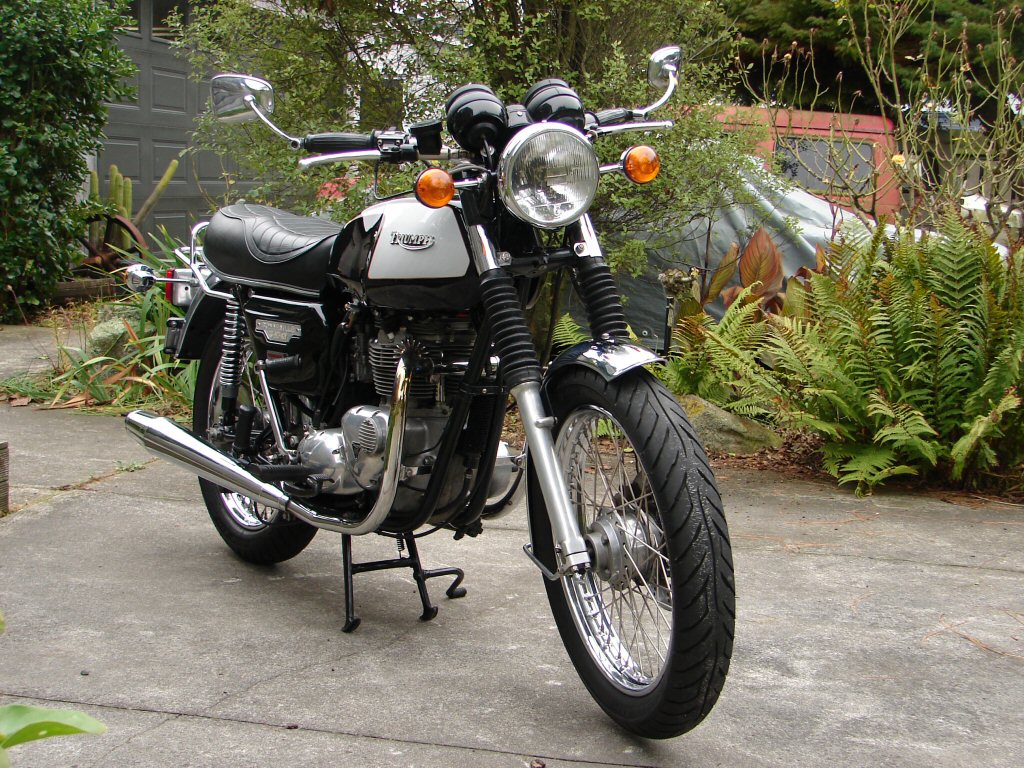May 2019
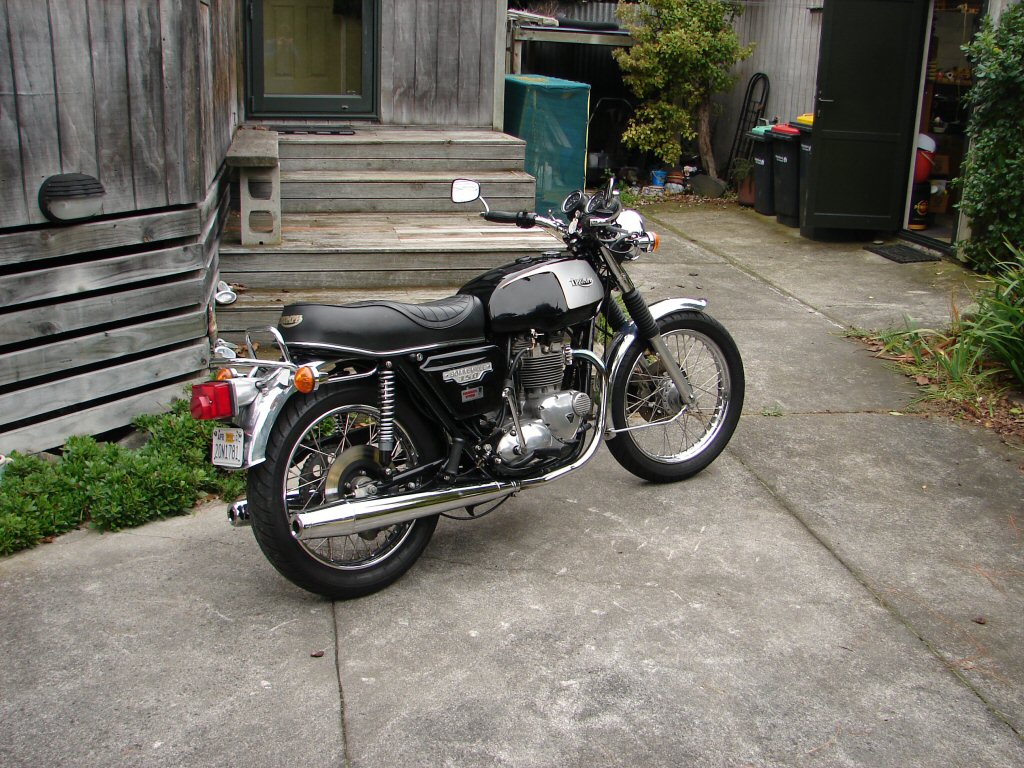
Same mate who owns the T160 had bought this smart T140 while he was living in the UK. It had been fussed over by previous owner and sported many new parts which was a bonus. It did not get much use over there, and when he moved back to NZ a year or so later the bike came too. It never got complied and did very few miles since being here either, but there had been a few tuning issues. The previous owner had not long fitted a new pair of ignition coils when he sold it, but it still had a mild problem. That same problem reappeared in NZ and the bike was submitted to a local bike guy for repair. He made some changes to the carb setup and the bike seemed better for a while, but went back to its old ways and then finally refused to go at all.
As we had just resurrected the T160 it seemed an appropriate time to see what might be ailing the T140.
Frankly - it looked like butter wouldn't melt..
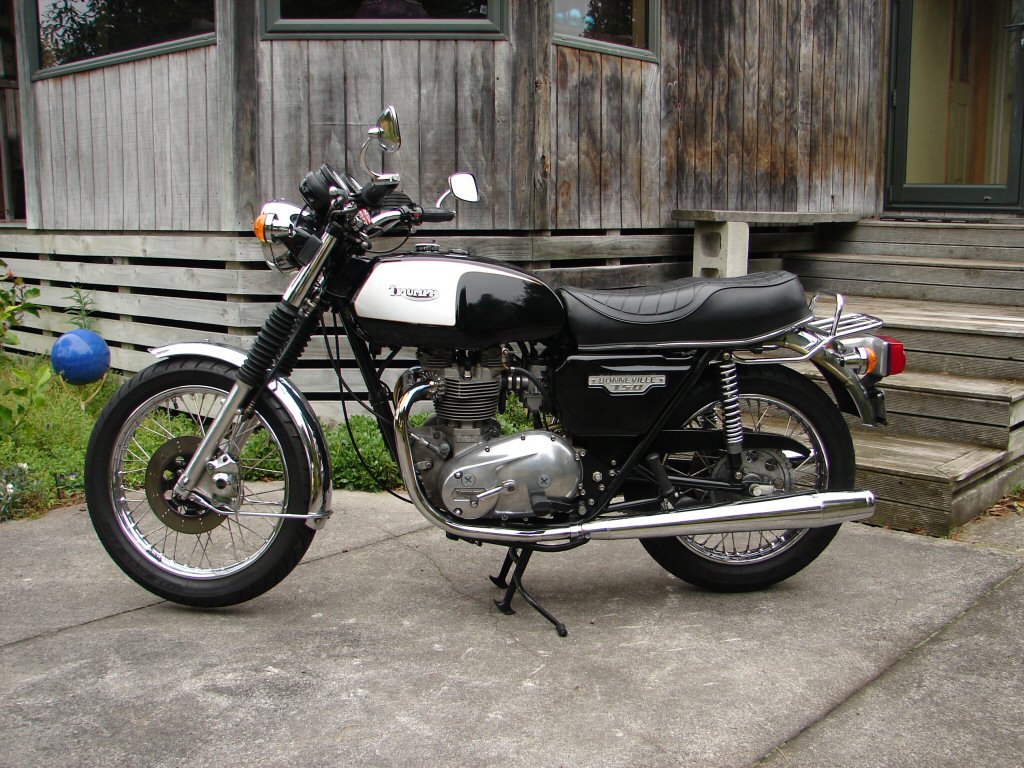
In a break with tradition when this bike was built Triumph fitted the newer Mk2 Amal carbs and an electronic ignition, albeit not an in-house jobbie, but the reliable Lucas Rita. That should have improved things from both an efficiency and a maintenance point of view and was probably a tad overdue. While I have not played with Mk2 Amals to any great length, their choke system seems to operate exceptionally well, and they are otherwise very similar in operation to the previous concentrics.
In a nice bit of synchronicity I had just recently worked on a 1979 T140 Special which had the exact same carbs and ignition, and I had found an achilles heel in the Lucas Rita setup which had caused a total loss of sparks on that bike. When we inspected this bike we also found a total lack of sparks, so I figured that the same issue may be present. This was namely a poor connection between the pickup and the amplifier box, so the box did not see the engine turning over and did not thus generate any switching of the coil power. There are two sets of Lucas bullet connectors between the pickup - they call it a reluctor - and the main unit which is sited behind the left sidecover. One set is beneath the fuel tank and the other right next to the amplifier unit. On the previous bike the problem pair had been next to the unit, and that area is exposed to spray from the rear wheel which doesn't help. The connectors did seem a bit on the loose side, so they got cleaned up and one of the connector sleeves replaced. The undertank pair got cleaned up too, but looked to be in good condition and receive a fair bit of warmth from the engine when in use.
Anyway, it worked because the bike fired up fairly readily and seemed as if it was happy to rev without misfiring. Subsequently when being ridden the misfire returned so it seemed that a rather more comprehensive approach might be necessary. As I would have to ensure that the bike was fit for a compliance check and then take it for one, the bike was delivered to me for that to happen.
As a pure coincidence while checking the resistance of various circuits I discovered that the Rita unit had no earth through its mounting. This meant that the entire alloy airfilter housing was not earthed despite being bolted to the frame, and this in turn meant that the zener diode had no earth so could not possibly do its job of regulating the charging voltage. The problem was traced to the fact that the frame had been repainted, and the powder coating not cleaned off at the airfilter housing mount so no earth was present. I ran a seperate wire to effect a good earth for all concerned.
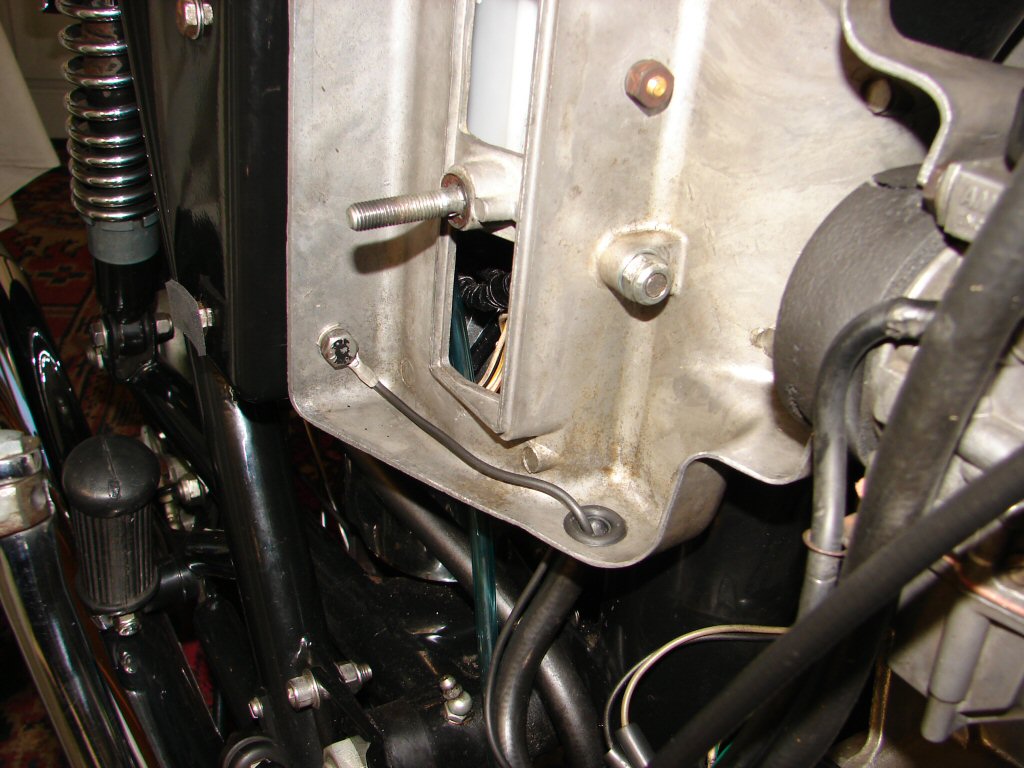
When I checked the bike I found that it would start in a reasonable fashion on the choke, but once the choke went off the engine would lose power, spit through the carbs and generally be unhappy until it finally stopped. It seemed way too lean, but with the choke left on it was way too rich. I removed and stripped the carbs to see what we had within. There are two sets of slide/needle/needle jet combinations for these models, one for UK use and another for the USA. This bike was a home market UK model, but while it had the UK slides, it had US needles and jets, and they looked rather new. I am pretty sure that the local guy fitted these to try and improve things, and initially it seemed he had. I decided to fit the standard bits first, as you have to begin somewhere. I also rechecked the ignition as the spark at the plugs seemed very weak when kicking the engine over, but better when turning the key off which is a best case scenario. Once the carbs were back on and I was able to run it, the cold start was improved but the choke off situation still unchanged. Running with the choke partially on did allow it to keep going, but the rich mixture then resulted in a fouled plug. I cleaned the plugs and checked that they both still worked, but the left side was extremely poor, so I wondered if the coils may have been an issue, certainly as the previous owner had seen fit to replace them. When I pulled them out I found that they were Wassell items. I do not have much faith in Wassell stuff, so I tried a spare pair of used Lucas coils to see what happened. Sparks visibly improved although still weaker on the left. I ran it briefly. Cold start was now very immediate, but during the trial the bike lost spark on the left side. I checked the plug leads and found that they were the carbon suppressor type, so I ripped them out and put copper wire in instead. My mate had fitted new "factory" leads during his ownership in an attempt to cure the misfire, but of course they had not.
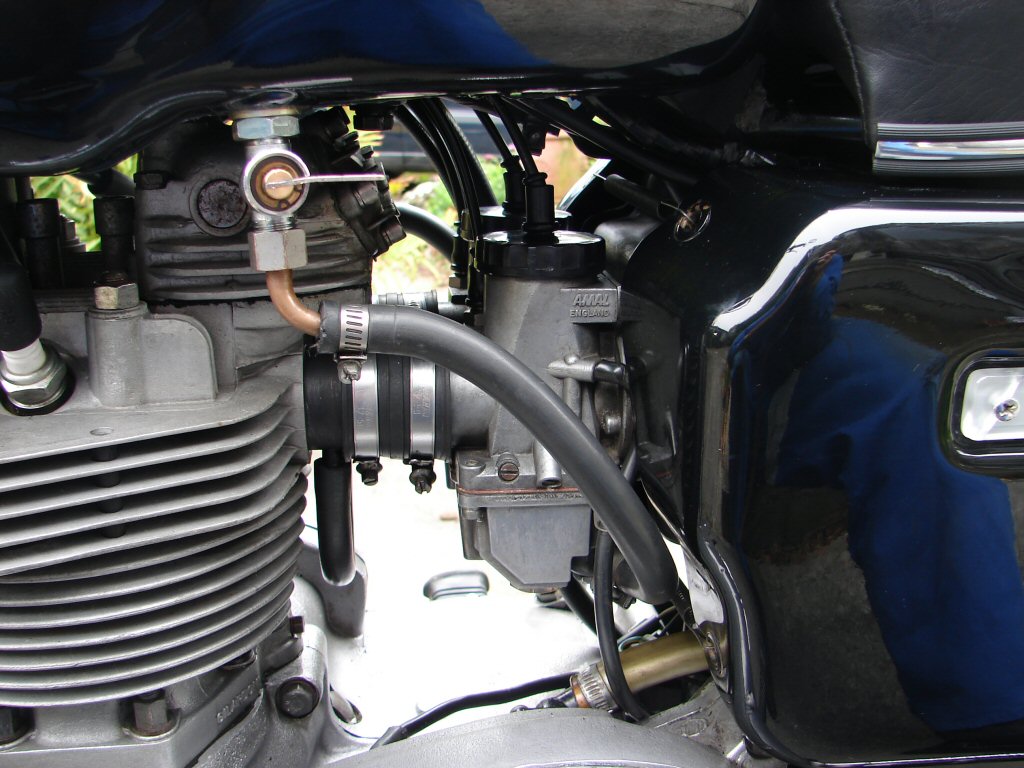
About now the new needles and jets showed up so the carbs came apart again and I compared all the bits. I found an interesting thing. Although the local mechanic had fitted larger needle jets as far as their stamped size indicated, they were actually smaller than the new stock jets. They were also made by Wassell, so no surprise then. However it did mean that someone else had tried to richen the mixture a bit.
Reviewing the situation I now formed the opinion that several people had tried to improve this bike, but unfortunately each one had introduced another problem. The ignition pickup problem was purely the result of corrosion and possibly bad storage or during shipping, but the weak coils, dud leads and poorly made jets had all added to the problem rather than curing it. Chances were that the original problem still existed.
With the carbs reassembled and refitted I started it yet again. Immediate cold start on the choke, and seemingly a slight improvement with the choke off, although still some spitting back through the carbs when opening the throttle. Then the left cylinder stopped firing. Well, we have replaced coils and leads, so it has to be the plug. Sure enough, so a spare pair of plugs fitted and it lit up with such enthusiasm that I phoned my mate and told him to come over and ride it.
We took a couple of bikes for a mile or two, him with a small amount of choke staying on to keep the mixture happy. We stopped halfway and he observed that while it was definitely running happily on both cylinders now, it still wasn't wanting to accelerate with any great gusto. We swapped bikes and I followed him home, and immediately got the impression that the timing was retarded. It just felt flat and lacklustre. Still progress though, and it was running as happily on both pots when we got home.
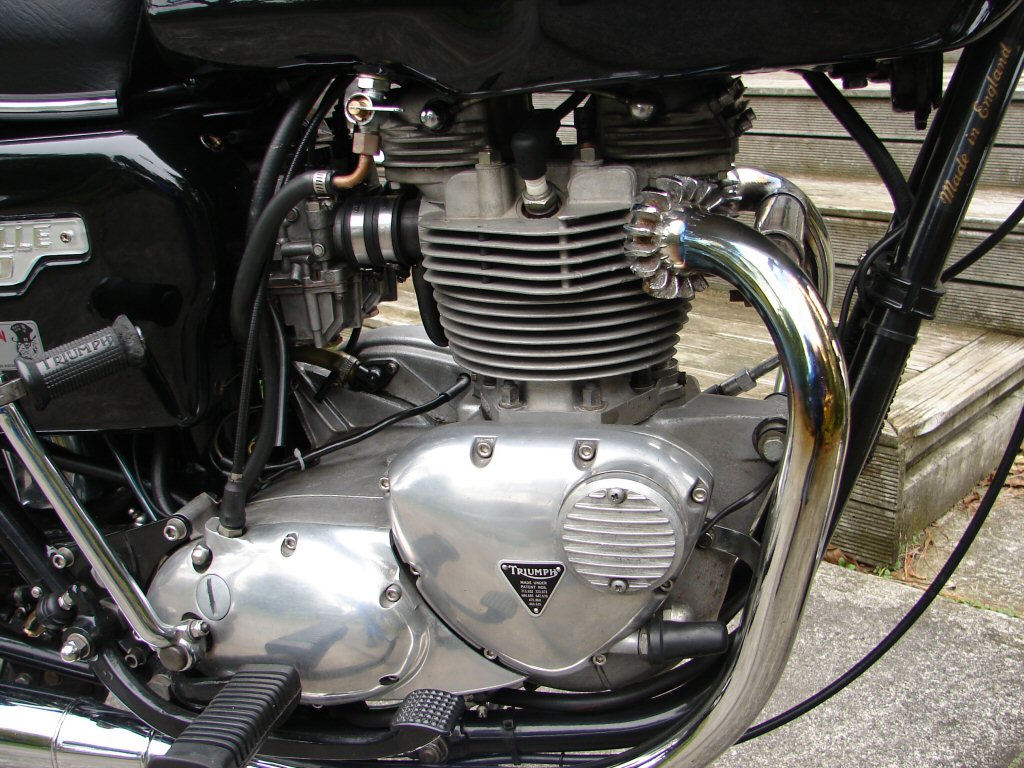
My mate had never touched the timing although he did not know if the mechanic had or not. I advanced the pickup by a small amount and rode the bike around the block. A very noticeable improvement but not enough. Next day I decided I would put a strobe light on it, but as I would want to warm it up first with a lap of the block I might as well advance it a tad further anyway. Wow. It was off, albeit still with the lean mixture symptoms, but as eager as an eager thing to get moving. I was really impressed. We were going to make this bike into a very nice runner indeed.
I had ordered a new pair of larger needle jets - made by Amal this time - and hopefully they would either sort the lean running completely or get us closer to it, but suddenly I got the call to deliver the bike for its compliance check and that had to take priority. I rode it down and it flew through the test with only one problem, the horn decided to play dead. It had given trouble previously but had been convinced to work by twiddling the adjuster screw, but now it was dead again. No doubt it had also suffered a bit of corrosion and would need to be cleaned up properly. We got a pass with the promise that this would happen.
Fresh from the compliance test, replete with token Californian numberplate seeing as it just looks wrong to ride without any plate at all..
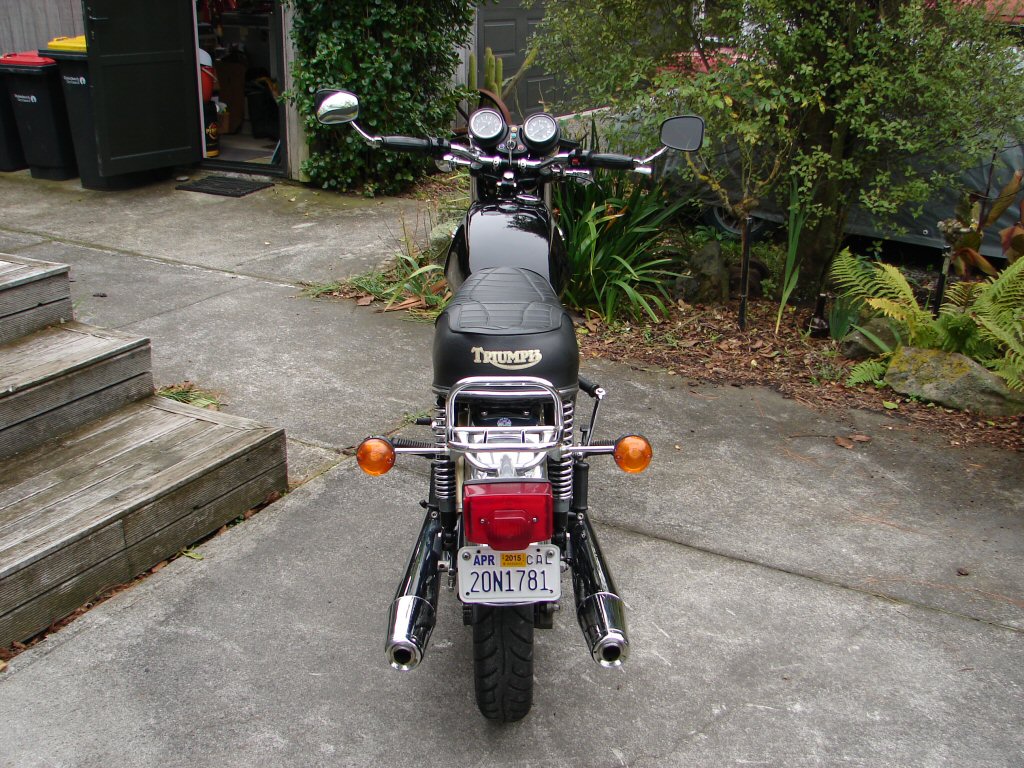
I am greatly in favour of the dash layout on the later models, styled much as my T160 is, but with the added benefit of more modern switchgear. They work well in use and the clocks are easy to keep an eye on. I have not ridden this at night, but it would probably benefit from having LEDs fitted inside the clocks rather than the tiny lamps which only manage a dull yellow glow as a norm. I also prefer the UK handlebar style to the US higher style. The latter might be ok around town but get a little wearisome on the highway in a nor'wester. A comfortable seat completes the rider appointments, slightly different to the item on the Special which is stepped up at the rear as a styling gesture, but both bikes are fun to ride and in my opinion the nicest of the T140s all up. I would be happy with either.
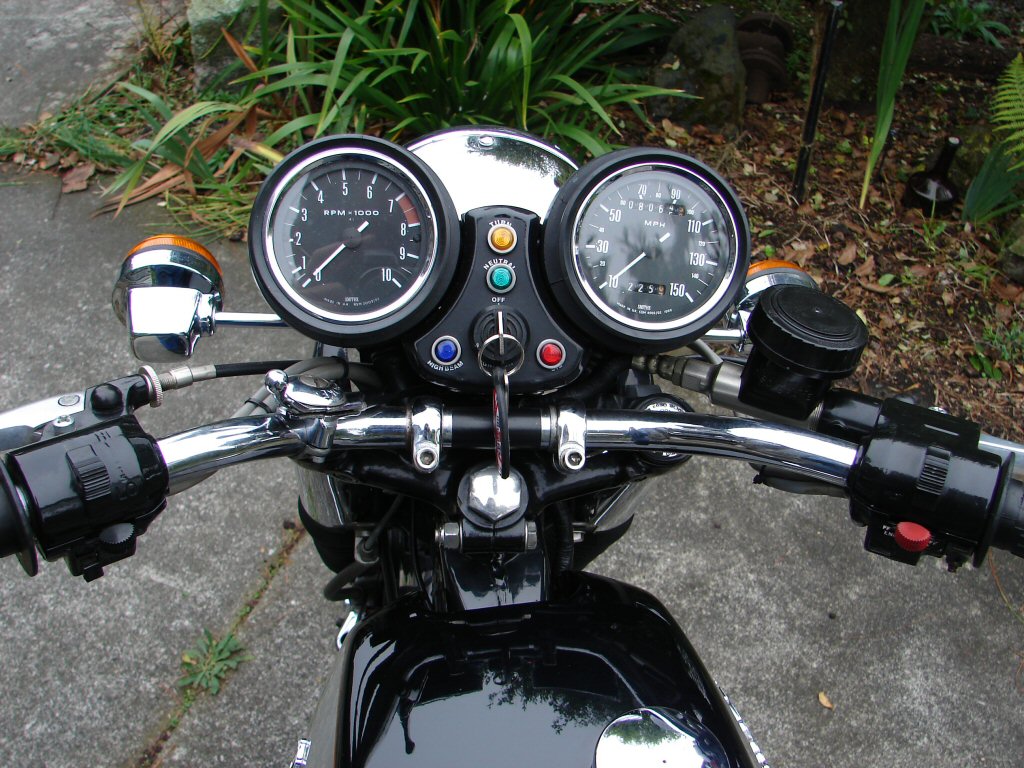
I would have also said that the Mk2 Amals are probably an improvement, but as yet I have not gotten to the point of being able to say that with confidence. The choke is certainly a winner, and cold starts are more a matter of fact than a test of procedure.
I feel very fortunate to have had experience of both these bikes, and even more so that they were here at the same time. Makes comparison a much more interesting event. The Special has lower gearing which makes it seem to be slower than the rate of gearchanging would suggest, but the "E" got the gearing spot-on and feels like quite a serious mover. I am looking forward to having the tuning sorted in order to get the full benefit.
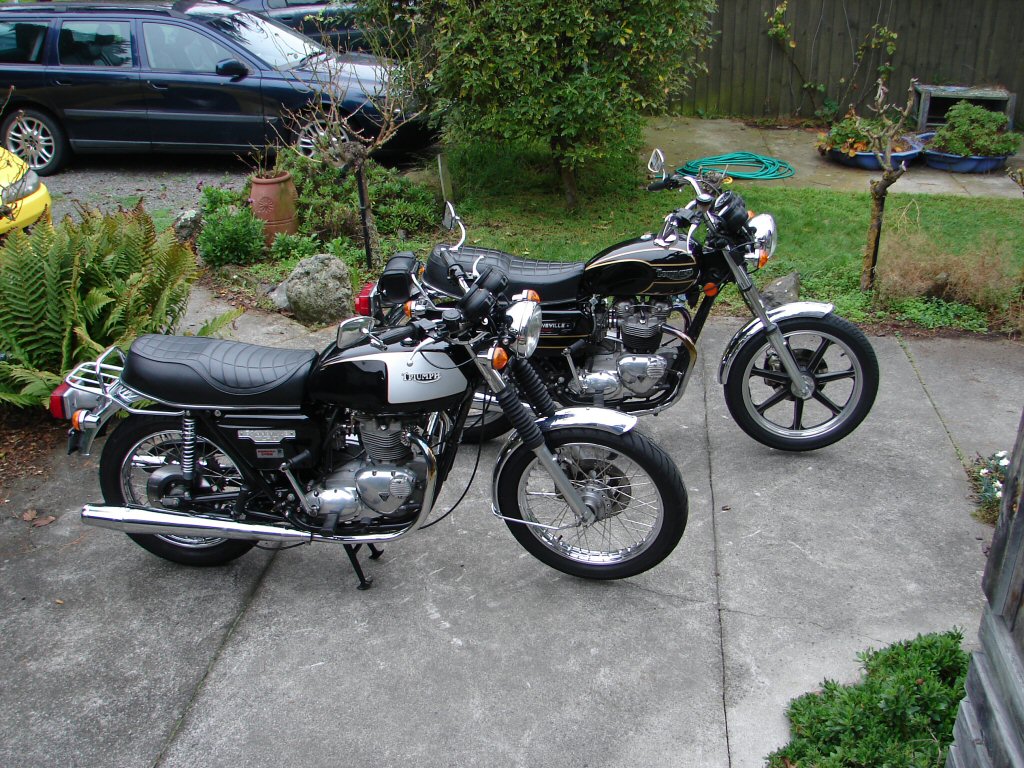
The new needle jets were fitted and everything reassembled. The cold start did not seem as chirpy as it had previously, but I was able to reduce the choke fairly quickly and the response off idle was a tad improved, but it was still not good enough for me to be happy with it. A brief ride confirmed this. I had discovered that the alternative needle which I had replaced was very slightly thinner than this OEM one, so I changed it back. I now had the factory "rich" settings albeit with proper Amal parts.
This time the results were far more optimistic. The cold start worked perfectly and the bike ran happily at fast idle until I slowly dropped the lever back. Idle was also happy after a bit of twiddling the idle stops and pilot screws. The only glitch was still a leanness immediately the slides lifted off the stops, and it was bad enough to prevent riding away smoothly. The tiniest amount of choke cured it immediately, confirming that it was definitely lean. Another play with the carbs revealed that both slides were worn enough to rattle quite a bit inside the bodies once lifted out of the base location. This would most likely be the cause of the problem and so a new set of hard anodised slides were now ordered. I did manage to use the timing light and found that I had slightly over-advanced it, so that was dropped back a fraction.
In other news, it appeared that the horn was dead. The adjuster screw snapped off. My friend decided he would drill the rivets out and see what was inside it. Having done so it appeared that it was only dirty points within that had caused it to stop, and it would most likely be repairable. Cool.! I had bought a cheap Chinese one just in case..
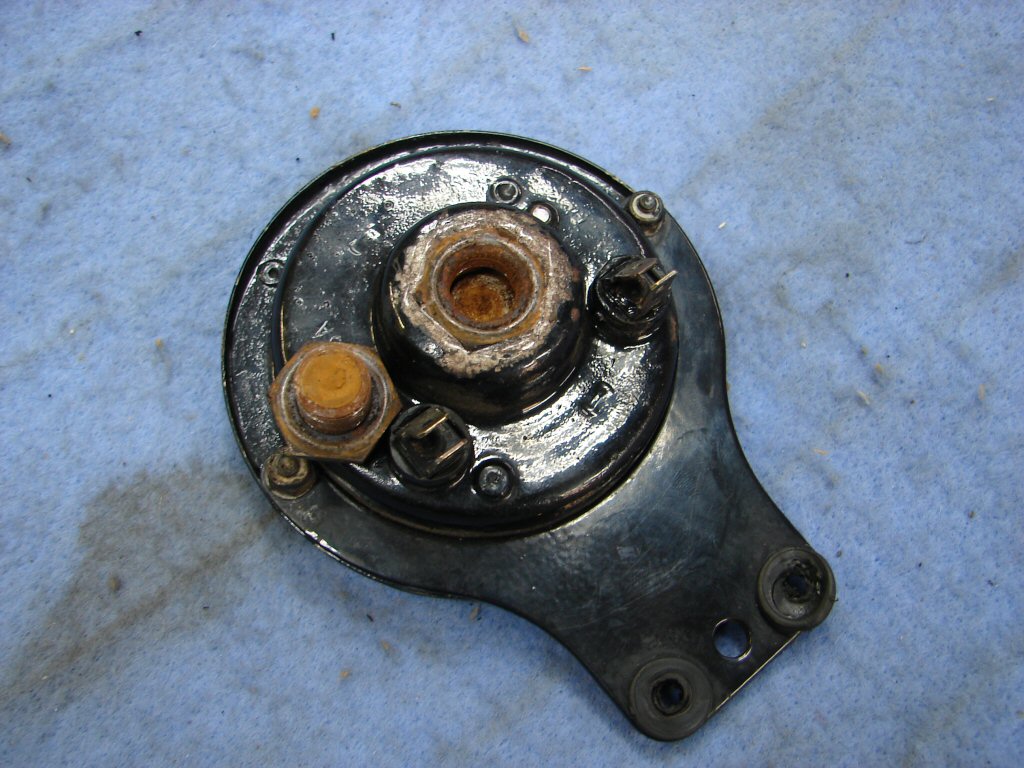
The new slides arrived and quite easily fitted just by removing the fuel tank but leaving the carbs mounted to the inlet manifold. After checking that they were a good fit in the bodies I fitted them properly and checked the synch of the two. To my surprise I found the right slide was considerably higher than the left, which was odd because I had tuned both cylinders individually and they were pretty happy at idle. I decided to refit the old slides for comparison and they were still at odds, so the carbs came off for diagnosis. It was obvious that the slides were sitting on the idle stops, so for some reason the engine preferred them to be as they now were.
So often one gets tunnel vision when chasing such issues, and it takes discipline to just pretend this is the first time you have looked at the current problem. And so I found the problem that I had missed, as had various others who had obviously been looking. When you find it you laugh out loud and wonder how you ever missed it. The right side carb spray tube was missing.! At least when peering through the throat it was not visible. Removing the slide and looking down revealed that it was still present but had dropped out of position and was sitting above the needle jet. Removing the jetholder allowed me to remove the spray tube completely and inspect it. While undamaged it appeared that the top edge which is usually swaged against the inside of the jetholding area had simply come loose and dropped. I peened the rolled lower edge after pushing it fully into place and found it to be secure. I applied the same approach to the left side one in case it might otherwise suffer the same fate. I then set both slides to the lower setting and put the whole lot back on the bike.
As soon as I was able I took it out for a test ride. The choke almost seemed too rich on what was a slightly warmer day, and in no time I was able to turn it completely off while the bike sat happily idling. Riding down the driveway I could immediately tell that the annoying leanness was gone, especially when cracking the throttle off the idle stops. Riding off down the road I was hard pressed not to laugh out loud. The tuning was perfect. I could not find any throttle setting in any gear or at any speed that would fail to get an instant and eager response which would continue unabated as long as you wanted or revs would allow.
At last.!
The repaired horn came back and while fitting it I added a new pair of spark plugs which were slightly hotter, purely because I had found info to suggest that these would work best for the jet and needle combination the bike now had.
